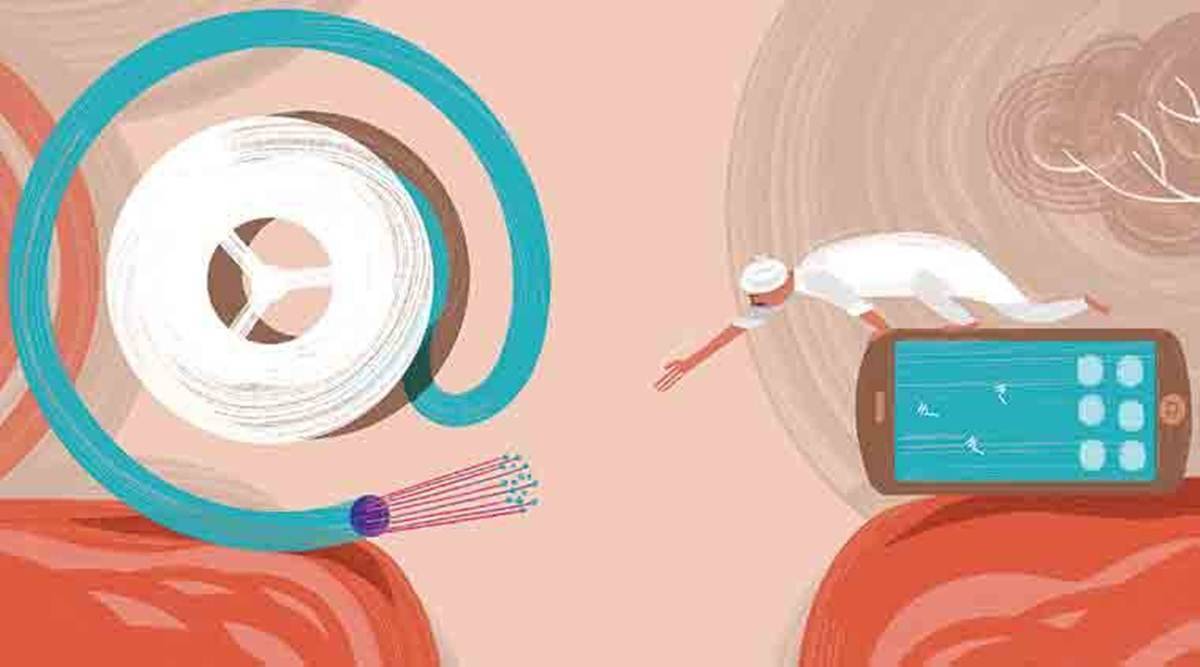On September 21, while inaugurating the ‘Ghar Tak Fibre’ scheme, Prime Minister Narendra Modi had said all 45,945 Bihar villages would be connected through the high-speed optical fibre.
The government’s ambitious ‘Ghar Tak Fibre’ scheme — which aims to connect all the villages with high-speed internet — is off to a slow start in poll-bound Bihar, the first state that aims to connect all its 45,945 villages by March 31, government data obtained by The Indian Express showed.
To connect all villages by March 31, the state would need to dig trenches, lay cables, and provide connectivity to an average of 257 villages daily, or a monthly average of over 7,500 villages. However, nearly a month after the scheme was inaugurated, optical fibre cable has been laid only in 4,347 villages as of October 14, or at the rate of 181 villages per day.
“Our present capacity is laying down between 80,000-100,000 km of optical fibre per year. To connect all the villages by March 31, 2021, we will need to lay down at least 200,000-225,000 km of optical fibre, which is a tough task,” an official said.
On September 21, while inaugurating the ‘Ghar Tak Fibre’ scheme, Prime Minister Narendra Modi had said all 45,945 Bihar villages would be connected through the high-speed optical fibre.
Lesson for future planning
The learnings from the implementation of the ‘Ghar Tak Fibre’ scheme in Bihar could also be a lesson for future, as the Centre plans to connect all 6.5 lakh villages to high speed optical fibre internet over the next 1,000 days.
The tender for providing connections and ‘lighting’ up these villages has not been floated so far and is likely to be floated only in the first week of November, senior government officials said. A village or a gram panchayat (GP) is considered ‘lit up’ under BharatNet when it consistently has internet connection and users at the end to verify the same. Of the 8,745 GPs in Bihar, 5,889 were connected to the state’s main internet grid under BharatNet phase one, while the remaining 2,856 were connected under phase two.
However, of all the GPs connected under phase one, about 60 per cent or 3,591 gram panchayats were non-operational as of October 15, while the status of another 200 was unclear.
In as many as 13 districts — including Jehanabad, Darbhanga, Purnia, Kishanganj, Vaishali, Araria, Saran and Jamuni — less than 25 per cent of the GPs connected to the internet under BharatNet phase one were operational. The main problems, an official said, were lack of power and related equipment failure, equipment theft, and faulty or lossy leased fibre.
“There are three main problems. One is that the lossy, old cables that were laid under phase one have to be replaced. So far, that work has been done in about 4,500 gram panchayats connected under phase one. Then the problem of right-of-way in laying cables from panchayats or blocks to individual villages. The third is power equipment failure and its theft,” the official added.
Around 42 per cent of 3,660 GPs reported to be non-operational in the state had been facing these problems, the data showed. While optical fibre cable has been laid to connect nearly all the 8,745 GPs, lack of users in these areas has resulted in minimal or zero follow-ups on repair and maintenance work, an official of the Department of Telecommunications (DoT) said.
“The first casualty of any construction work done by state or private agencies is the cable laid underground. Since there is near-zero communication between various agencies of the state government itself, most of these cables have been damaged. Now since there are no users to complain about the snapped connections, no one ever comes to know if the cables have been damaged,” the official said.
Under the Ghar Tak Fibre scheme, Bihar has to provide at least five fibre-to-the-home (FTTH) connections per village, while there should also be at least one WiFi hotspot per village. However, as of October 14, only 30,768 FTTH connections had been given, while only 2,531 WiFi hotspots had been installed so far under BharatNet phase one.
The BharatNet project, which initially began as the National Optical Fibre Network in October 2011, has been delayed for over 92 months now. The new deadline is set at August 2021. However, on August 15 this year, the PM said all villages in the country would be connected to the internet over the next 1,000 days, which means that the project is now likely to be completed only by 2024.
? The Indian Express is now on Telegram. Click here to join our channel (@indianexpress) and stay updated with the latest headlines
For all the latest Business News, download Indian Express App.
Source: Read Full Article


